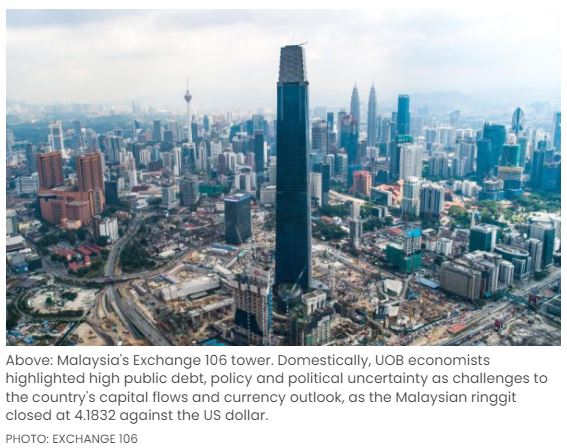Greater differentiation in foreign flows dynamics to come for Malaysia in 2022: UOB
UOB expects greater differentiation on foreign flows dynamics in emerging markets including Malaysia for 2022, despite overseas investors continuing to pile into Malaysia capital markets in January.
This comes as most regional central banks’ patience on rates to sustain growth recovery went against hawkish pivots by both the US Federal Reserve and European Central Bank earlier this year, as well as back-to-back rate hikes by the Bank of England and the Bank of Korea, the bank said in a note on Friday (Feb 11).
UOB also observed that global financial volatility has increased significantly since late-December 2021, over fears of tighter monetary conditions with inflation on the rise and Omicron’s spread in major economies.
Domestically, UOB economists highlighted high public debt, policy and political uncertainty as challenges to the country’s capital flows and currency outlook, as the Malaysian ringgit closed at 4.1832 against the US dollar.
Foreign inflows could also be affected in the near-term by upcoming events, including the January US Federal Open Market Committee (FOMC) meeting minutes on Feb 17 and Malaysian central bank Bank Negara Malaysia’s policy rate decision on Mar 3.
In January, Malaysia had foreign portfolio inflows totalling RM3.8 billion (S$1.2 billion), an increase of RM5 billion from December 2021, which were channelled into the country’s debt securities and equities.
Foreign debt inflows for the month were at RM4.6 billion and went only into Malaysian government securities, as other debt instruments recorded outflows. Foreign investors therefore increased their holdings of these securities to a new high of RM194.1 billion, which accounted for 39.6 per cent of total government securities outstanding.
As for government investment issues, overseas investors reduced their holdings to RM44.2 billion or 10.4 per cent of total government issues outstanding.
In total, non-resident holdings of Malaysian government bonds, which include both government securities and government investment issues, went up by RM4.3 billion to RM238.2 billion.
This is equivalent to 25.5 per cent of total government bond outstanding, which UOB says is the highest since April 2021.
At the end of January, foreign ownership of Malaysian equities edged down to 20.2 per cent of market capitalisation.
Meanwhile, Bank Negara Malaysia said its foreign reserves fell for the first time in 4 months by US$0.8 billion month on month to US$116.1 billion at the end of January, although it said the amount is still sufficient to finance 7.5 months of retained imports and is 1.2 times total short-term external debt.
Bank Negara Malaysia has not yet posted its January 2022 FX swaps data, but UOB noted that its December 2021 net short position in FX swaps widened by US$0.3 billion to US$7.6 billion, accounting for 6.5 per cent of total foreign reserves.
Source: https://www.businesstimes.com.sg/asean-business/greater-differentiation-in-foreign-flows-dynamics-to-come-for-malaysia-in-2022-uob


 Thailand
Thailand




